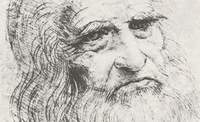Italian police hunt for new Da Vinci code
A real-life Da Vinci mystery, complete with tantalizing clues and cunning art sleuths, may be one step closer to a solution, as researchers resume the search for a lost Leonardo masterpiece believed to be concealed behind a wall in Florence's Palazzo Vecchio.

Culture Minister Francesco Rutelli and officials in the Tuscan city announced this week they had given their go-ahead for renewed exploration in the palace, which houses Florence's city offices. There, some researchers believe, a cavity in one of the walls may have preserved for more than four centuries Leonardo's unfinished mural painting of the "Battle of Anghiari."
"We took this decision to verify conclusively if the cavity exists and if there are traces of the fresco," Rutelli said during a visit in Florence.
The search for the Renaissance masterpiece began about 30 years ago, when art researcher Maurizio Seracini noticed a cryptic message painted on one of the frescoes decorating the "Hall of the 500" - once the city's seat of power.
"Cerca, trova" - "seek and you shall find" - said the words on a tiny green flag in the "Battle of Marciano in the Chiana Valley," one of the military scenes painted by 16th-century artist Giorgio Vasari.
Between 2002 and 2003, radar and X-ray scans allowed Seracini and his team to find a cavity behind the fresco that is the right size to cocoon Leonardo's work, which was long thought to have been destroyed when Vasari renovated the hall in the mid-16th century.
But shortly after the initial discovery, Seracini's decades-long quest came to a standstill when authorities refused to renew his survey permit.
"We are not talking about a search like any other," Seracini told The Associated Press in a telephone interview. "We are searching for Leonardo's greatest masterpiece, considered as such also by his contemporaries."
Leonardo began working on the "Battle of Anghiari" in 1505, when he was 53. He worked alongside fellow artist and rival Michelangelo, who had been commissioned to decorate the opposite wall of the council hall, which was to have scenes of the Florentine republic's military triumphs.
The pairing of two great artists created ripples of excitement in art-loving Florence, but both men soon left for other cities.
Michelangelo never went beyond the preparatory work for his "Battle of Cascina," but Leonardo did eventually paint his battle's centerpiece - a violent clash of horses and men called the "Fight for the Flag," which is known today through Leonardo's preparatory studies and copies made by other artists.
Some chroniclers of the time said Da Vinci had experimented with unstable paints that had rapidly degraded, leaving the painting irreparably damaged.
But Seracini said documents show that at least the centerpiece was admired and copied for decades, until Vasari began his work at Palazzo Vecchio. Vasari himself, who wrote biographies of several artists including Leonardo, would have been loath to destroy Leonardo's work. He is known to have salvaged other art by leaving works cocooned between walls when he made renovations, the researcher said.
Seracini, whose research on another Leonardo painting is quoted in Dan Brown's best-selling novel "The Da Vinci Code," is an engineer who has spent the last three decades conducting scientific investigations on priceless art treasures.
Florence city officials said that a date has not been set yet for the new investigation, as details still needed approval.
While the new research will be supervised by the Opificio delle Pietre Dure, one of Italy's top restoration institutes, Seracini will be kept on the team, said Alessandra Garzanti, a spokeswoman at Florence's municipality, the AP says.
"He brought this forward until now, it would be stupid to leave him out," she said.
Once the work starts, researchers would need a year and a half to give a definitive answer, Seracini said.
"After such a long wait ... we will finally know if the painting is there or not," he said.
The work would include documentary research to determine which chemicals Leonardo used to paint the fresco, and subsequent scans to see if those pigments are present behind the wall, he said.
Seracini declined to reveal how the scans would work, saying the method was still experimental. However, he said the analysis would not involve probes or other instruments that would damage the overlying Vasari fresco.
Subscribe to Pravda.Ru Telegram channel, Facebook, RSS!


